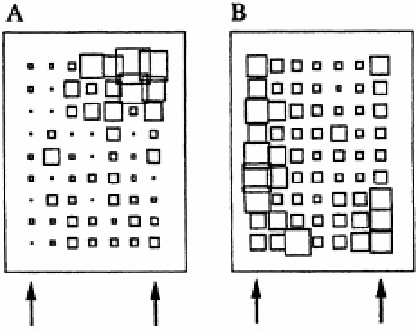Agriculture Reference
In-Depth Information
Spatial distribution
At a mesoscale level of approach, that of an experimental plot, the horizontal distribution
of nematode populations is very uneven. At sites in nine prairies in Iowa, Schmitt and
Norton (1972) found more heterogeneity within than between sites. In a soy-bean field
in Michigan, Robertson and Freckman (in Roberston, 1994) found nematodes to be
distributed in large patches
ca.
200 m in diameter with population density variations
spanning two orders of magnitude. In tundra soils, nematode communities reflect the
mosaic of microsites with densities a hundred times greater in grass stands than in bare
soil (Kuzmin, 1976). Similar differences have also been reported for soil within and
between rows in cultivated soils (Ferris and McHenry, 1976) and in a sugarcane field in
Martinique (Rossi
et al.,
1996, Figure III.29).
Such factors as total-C, assimilable P, pH, Ca, aeration and moisture may influence
the micro-distribution of nematodes (Yeates, 1981). Interactions with other organisms,
especially roots (which attract them) or earthworms (whose activities depress nematode
populations) also modify distribution patterns (Yeates, 1981). In consequence, the distri-
bution of phytoparasitic nematodes in cultivated fields largely reflects that of the plants
(Francl, 1986).
Vertical distribution
Nematode populations are generally concentrated in the upper 5 to 10 cm of soil
although they may also occur at depths of 50 cm and more (Sohlenius and Sandor, 1987).
Their distribution follows those of site organic resources and thus forest communities
have more superficial patterns of vertical distribution than grassland communities (see,
e.g.,
Yeates and Coleman, 1982; Hota
et al.,
1988). Vertical migration is limited, with
most movement being due to transport on growing root-tips (Yeates, 1981). Significant
differences exist between populations of different species and ecological categories


